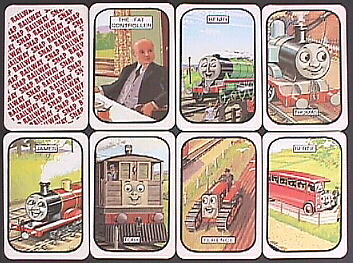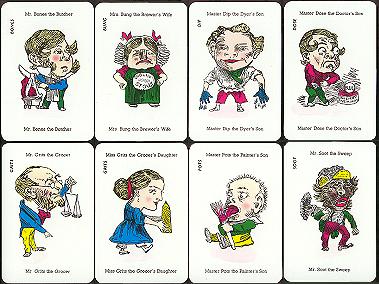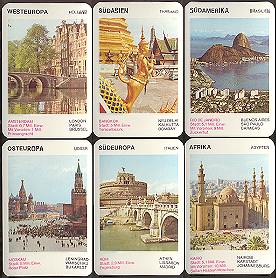DISCLAIMER
the content of these galleries is a private property
neither the text nor the pictures may be republished, nor used for any purpose, without the author's permission
Various Games - part 1
DOMINO
OLD MAID ~ SCHWARTZ PETER ~ CERNÝ PETR ~ FEKETE PÉTER ~ UOMO NERO
SNAP
HAPPY FAMILIES ~ QUARTETT ~ KVARTETO
go to part 2
CUCKOO ˇ ROOK ˇ LEXICON ˇ SOLO ˇ UNO
WHOT! ˇ GET OUT! ˇ DUMMY ˇ TAKE 6
a credit to Bo Bernville for his precious information about
the Kille deck, and one to Ingo Werner for his feedback about Quartett
Several packs of cards are specially designed for games which do not need classic suits.
They may either have no suits at all (i.e. all picture cards, or values belonging to
only one family), or sometimes they may be divided into families according to colours.
Some of these games are modern, but many of them have an old tradition, and are usually known only in
one country or in areas with the same cultural background.
The main difference of these cards, though, is that almost all of them have been
created for non-gambling games, thus making them suitable for players of all ages.
Besides actual decks which belong to this group, a different kind of collectable item are
trading cards; these ones, though, are not made for playing card games. They usually feature
single or multiple sets of cartoon series characters (such as the recent Pokémon), or fantasy personages
(Magic is the best known example). Obviously, these ones will not be dealt with,
having little in common with playing cards.
DOMINO CARDS
Domino is a popular pastime played with tiles, but also a few card decks have been
produced for this game: some of them are very simple, as the Indonesian one shown below,
but the ones produced in western countries are usually more colourful, often designed for
children, as the Italian Zoo Domino deck on the left.
Rules are usually the same as in the tile game, i.e. to match pieces by the values or by the
pictures on both ends.

Domino deck (by Kalong, Indonesia) |

Zoo Domino deck, with pictures of wild animals
(by Dal Negro, Italy)
For traditional Chinese domino decks see Fifteen Point Cards and Sichuan Cards
in page 2 of the Chinese gallery.
|
OLD MAID ~ SCHWARZ PETER ~ CERNÝ PETR ~ FEKETE PÉTER ~ UOMO NERO
Old Maid is a traditional game in most English-speaking countries.
It is played with a deck of 33 picture cards, in which all but one of the subjects are repeated twice, forming
16 couples. The last card is single, and it usually features an old woman or spinster,
whence the name of the game.
By picking cards in turn from each other's hands, the players try to discard couples, and to
avoid being left the Old Maid, whose holder at the end of the round is the loser. |

Old Maid deck with traditional subjects (by Emu for the UK) |

Cerný Petr deck featuring dog personages
(by OTK, Czech Republic) |
The subjects in traditional Old Maid decks are personages borrowed from everyday's life
(the postman, the driver, the fisherman, the butcher, etc.), without a given scheme,
but some editions are also inspired by a variety of specific themes; in this case,
the "old maid" too is usually pictured in a pertinent attitude.
The same game is even more popular in German-speaking
countries and those related to German culture (Czech Republic, Slovakia, Hungary, Croatia),
where the game is known as Schwarz Peter ("Black Peter"), in the local
language variants: Cerný Petr (Czech), Cierny Peter (Slovak) and
Fekete Péter (Hungarian).
In these varieties the "black Peter" is often a chimney-sweeper. |
An Italian game which is the same as the previous
ones is called Uomo Nero ("black man", or "bogie man"). It is normally played with
regional patterns, by taking one card out of the deck (usually and ace), and by considering
the ace of Batons the unlucky personage not to be left with.
Italian picture card decks for this game, such as the one shown, are therefore very
unusual. In this particular edition the two cards of each couple are not identical; a small
sign or symbol (a music note, a tennis ball, an anchor, etc.) act as reminders for making
a correct match. Only the individual card has no sign. |

Uomo Nero deck (by Modiano, Italy):
the individual personage and three sample couples |

Snap deck with original illustrations
from John Jaques' 19th century edition
(by Gibson Games, UK) |
SNAP
Snap is a typical British family game. The 44 cards have 22 illustrations repeated in
couples, either inspired by everyday's life or by specific themes, as the Old Maid cards.
The rules of the game are simple: players are dealt all the cards in the pack, which are kept in a pile, face down in
front of them; at the beginning of the game, the first player rapidly uncovers his upmost card,
so that everyone can see it, and places it near his pile of unturned cards; all other players
do the same, in turn.
|
If one of the exposed cards matches with the one belonging to any other player, the two
opponents shout "SNAP!" as fast as they can, and who is first in doing so adds all the
exposed cards of the other player to his own uncovered pile, placing them at the bottom. If
the two players call "SNAP" exactly at the same time, their upturned cards go in the
centre of the table (in the 'pool'); if a player calls "SNAP" in error, his upturned
cards go in the 'pool' as well. The 'pool' is therefore made of several individual piles of
exposed cards.
|

a colourful Woodland Snap
deck, featuring personages
from a popular children series (by Gibson Games, UK) |
 |
When somebody turns up a card matching the top card of a 'pool' pile, any player
can call "SNAP-POOL", and the first in doing so adds that 'pool' pile to his uncovered cards.
When a player has no more uncovered cards to turn he is out of the game. The winner of the round is
the player who survives all the others.
Railway Snap deck, featuring
characters
from the popular "Thomas the Train" series
(printed in Belgium for Michael Stanfield, UK)
|
HAPPY FAMILIES ~ QUARTETT ~ KVARTETO
Happy Families is another popular British game for children, whose 44-card deck
features characters from different families: in traditional packs each family is made by a worker
(the Baker, the Painter, etc.), his wife, his daughter and his son. The game is played by
asking the opponents for cards belonging to specific families, so to complete as many sets
as possible.
Happy Families may be even played by using a standard deck
of cards, but the different characters in the family groups are surely more fun to play
with.
|

Jaques Happy Families deck, with illustrations from
John Jaques' original edition (by Gibson Games, UK) |

Quartett deck, whose subjects are cities
of the world (by Piatnik, Austria) |
Quartett is the German version of the game: it has the same rules, though
the deck has 36 cards. Therefore, groups (or families) are nine, each of which featuring
four different picture cards.
Both in Germany and in Austria, several important manufacturers such as Piatnik,
Berliner Spielkarten, F.X. Schmidt, and others have produced Quartett decks, with a great
variety of subjects: animals, cities of the world, cars, etc.
Regretfully, having card games turned less popular than two or three decades ago,
the wide range of Quartett decks inspired by different themes, once available,
has now considerably shrunk.
|
Kvarteto is the Czech version of the game, identical to
the German one. In the Czech Republic the game is still popular, so besides editions with traditional
illustrations, newer ones with themes such as cartoon series or movies exist
(as the sample shown on the right, inspired by "The Jungle Book").
In both cases, the four-card families are numbered for an easier reference, and their
subjects are identified as "1A-1B-1C-1D", "2A-2B-2C-2D", etc.
A very good selection of Quartett decks is shown in Ingo Werner's page
Im Reich der Quartette. |

modern Kvarteto deck with personages from "The Jungle Book"
(by OTK, Czech Republic); note the use of numbers to identify the subjects |
go to part 2
CUCKOO ˇ ROOK ˇ LEXICON ˇ SOLO ˇ UNO
WHOT! ˇ GET OUT! ˇ DUMMY ˇ TAKE 6
OTHER GALLERIES






















or back to

INTRODUCTION
AND HISTORY
|

MULTI-LANGUAGE
GLOSSARY |

THE FOOL &
THE JOKER |

INDEX
TABLE |

REGIONAL
GAMES |

PLAYING CARD
LINKS |
|